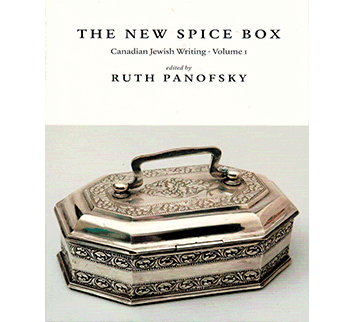Anthologies are designed to offer an introduction and to elucidate a tradition’s development and its highlights. They bear the weighty responsibility of offering what is thought to be necessary reading by dominant voices.
Ruth Panofsky approaches these generic expectations with particular originality in the maiden volume of what will be a two-volume set entitled The New Spice Box: Canadian Jewish Writing. In her introductory account of her search for “focus and unique parameters” for the anthology, she highlights the example set by the 1981 anthology entitled The Spice Box: An Anthology of Canadian Jewish Writing, whose “landmark collection” included translations from the Yiddish, poetry by Irving Layton, A.M. Klein, Leonard Cohen, and Irving Layton, alongside prose by Mordecai Richer and Adele Wiseman. Panofsky’s New Spice Box took shape in relation to its predecessor, and she is careful not to reproduce the established canon.
My 1981 edition of The Spice Box was bought at a launch held at the Vancouver Jewish Community Centre, where – in what seems today to be an imaginary encounter – Layton read his poems with his usual bluster and aplomb.
READ: ZUNDEL’S GONE, BUT WE MUST NEVER STOP FIGHTING THE PURVEYORS OF HATE AND LIES
Included in The New Spice Box is Ken Sherman, one of the many young poets Layton supported. In a recent collection, Sherman recalls how Layton “welcomed” him, “a neophyte with manuscript in trembling hand.” Sherman’s contribution to The New Spice Box is not verse, but one of his assured memoiristic accounts of ancestral influence. His Polish grandfather’s way with a Canadian life is part of what Sherman has to tell, but through his father’s years as a tailor on Toronto’s College Street, Sherman arrives at an
account of where these ancestral accomplishments leave a young poet.
This presentation of a contemporary Canadian view by way of its links with a European past is key to many of the works Panofsky includes. Writers collected in 1981’s The Spice Box were less inclined to write their way back to their ancestors’ European lives.
Panofsky’s choices signal a shift in writerly goals that took shape at the same time as the collapse of the Soviet grip on eastern Europe. The transformation of life in ex-Soviet states, and a new ability to travel to the east, led writers to reconsider their relationship with their ancestral past. Such reconsideration is found in many pieces in The New Spice Box. And with it, Panofsky acknowledges the formative role of Yiddish writers in the Canadian Jewish tradition.
The exploration of a European-Canadian axis is initiated by Shulamis Yelin and Chava Rosenfarb (the former born in Montreal, the latter in Lodz, Poland). It is maintained with clarity and emotion in writing by Sherman, S. Weilbach, Seymour Mayne, Helen Weinzweig, J.J. Steinfeld, Karen Shenfeld, Judith Kalman, Gabriella Goliger, and Eva Hoffman. This is a deep excavation, as Panofsky puts it in her introduction, of the impact of “historic events” and “cultural inheritance.”
Memoir and memoiristic fiction are favoured modes by which the anthology’s writers explore these themes. Rosenfarb’s contribution is a diary written in Bergen-Belsen shortly after liberation. Weilbach’s contribution is a related piece, depicting the travails of German-Jewish refugees in wartime England. Judith Kalman’s The County of Birches is part of a suite of autobiographical stories depicting Jewish survivors in postwar Hungary, prior to their departure for Canada.
Kalman’s piece, like Sherman’s, turns memoir into moving literary writing. In it, a family anecdote, which the reader assumes is based on actual events, centres on a pair of Jewish overseers in a Hungarian forced labour detail at Yom Kippur-time. Kalman’s way of telling her ancestral past leaves us with the image of Jewish slave labourers at prayer: “Men scattered in the woods, swaying silently, lost in their own private worlds like inmates in an asylum for lunatics. One madman swinging an axe. A company of mindless mutes, facing east, swaying on its heels.”
Alongside such sharp imaginings of Europe, readers will look for Canadian tableaux. There is Sherman’s College Street tailor shop. And Yelin’s Montreal schoolyard. Goliger’s story offers a hint of Toronto’s ravines in summer. Eva Hoffman’s memoir of 1950s Vancouver, titled Exile, depicts an estranged place where “shaggy rug in the bathroom and toilet paper that comes in different colours” strike an ex-Krakowian as evidence that she has come to a cultural wasteland.
These through-lines linking selections in The New Spice Box propose possibilities rarely found in anthologies, where comprehensiveness – a kind of greatest hits approach – most often makes it unlikely for links between contributors to assert themselves so energetically. The New Spice Box presents its own compelling narrative of a changing literary tradition.
Norman Ravvin is a writer and teacher in Montreal.










